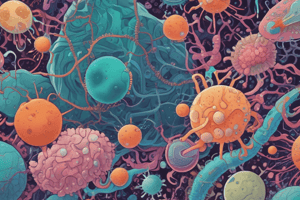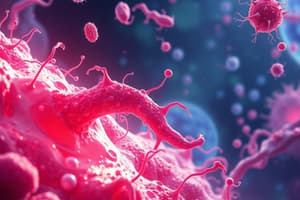Podcast
Questions and Answers
What is the primary function of the capsule in bacterial structure?
What is the primary function of the capsule in bacterial structure?
- To synthesize ATP during photosynthesis
- To provide motility to the bacterium
- To regulate the transport of nutrients
- To protect the bacterium from phagocytosis (correct)
Which type of bacteria can thrive in both aerobic and anaerobic conditions?
Which type of bacteria can thrive in both aerobic and anaerobic conditions?
- Microaerophilic bacteria
- Aerotolerant bacteria
- Obligate anaerobic bacteria
- Facultative anaerobic bacteria (correct)
What is the process by which bacteria divide into two identical daughter cells?
What is the process by which bacteria divide into two identical daughter cells?
- Mitosis
- Endosymbiosis
- Binary fission (correct)
- Meiosis
Which of the following is an example of an autotrophic bacterium?
Which of the following is an example of an autotrophic bacterium?
What is the term for the time required for a bacterial population to double in number?
What is the term for the time required for a bacterial population to double in number?
Which of the following is an application of bacteriology in the environment?
Which of the following is an application of bacteriology in the environment?
What is the primary mechanism by which bacteria can develop acquired resistance to antibiotics?
What is the primary mechanism by which bacteria can develop acquired resistance to antibiotics?
Which of the following types of antibiotic resistance is typically inherent to a particular bacterial species?
Which of the following types of antibiotic resistance is typically inherent to a particular bacterial species?
What is a major consequence of the global spread of antibiotic-resistant strains?
What is a major consequence of the global spread of antibiotic-resistant strains?
Which of the following strategies is NOT a direct approach to combat antibiotic resistance?
Which of the following strategies is NOT a direct approach to combat antibiotic resistance?
What is the primary factor contributing to the development of antibiotic resistance due to the misuse of antibiotics?
What is the primary factor contributing to the development of antibiotic resistance due to the misuse of antibiotics?
Which of the following mechanisms of antibiotic resistance involves the breakdown of antibiotics by bacterial enzymes?
Which of the following mechanisms of antibiotic resistance involves the breakdown of antibiotics by bacterial enzymes?
Flashcards are hidden until you start studying
Study Notes
Definition and Scope
- Bacteriology is the branch of microbiology that deals with the study of bacteria.
- It involves the study of bacterial structure, function, growth, evolution, classification, and identification.
- Bacteriology also explores the role of bacteria in disease, environment, and industry.
Classification of Bacteria
- Based on cell wall composition:
- Gram-positive bacteria (thick peptidoglycan layer)
- Gram-negative bacteria (thin peptidoglycan layer, outer membrane)
- Based on shape:
- Spherical (cocci)
- Rod-shaped (bacilli)
- Spiral-shaped (spirilla)
- Comma-shaped (vibrios)
- Based on oxygen requirements:
- Aerobic bacteria (require oxygen)
- Anaerobic bacteria (do not require oxygen)
- Facultative anaerobic bacteria (can thrive in both aerobic and anaerobic conditions)
Bacterial Structure
- Cell wall: peptidoglycan (also known as murein)
- Cell membrane: phospholipid bilayer
- Cytoplasm: contains genetic material, ribosomes, and various organelles
- Flagella: responsible for bacterial motility
- Capsule: outer layer of polysaccharides, protects bacteria from phagocytosis
Bacterial Growth and Reproduction
- Binary fission: process by which bacteria divide into two identical daughter cells
- Generation time: time required for a bacterial population to double in number
- Factors affecting bacterial growth:
- Temperature
- pH
- Nutrient availability
- Osmotic pressure
Bacterial Metabolism
- Autotrophic bacteria: produce their own food using light or chemical energy
- Heterotrophic bacteria: obtain energy by breaking down organic compounds
- Fermentation: anaerobic process by which bacteria generate energy
- Respiratory pathways: aerobic and anaerobic processes by which bacteria generate energy
Bacterial Pathogenesis
- Mechanisms of pathogenesis:
- Toxin production
- Adhesion and invasion
- Immune evasion
- Virulence factors
- Examples of bacterial diseases:
- Tuberculosis
- Pneumonia
- Meningitis
- Food poisoning
Applications of Bacteriology
- Medicine: development of vaccines, antibiotics, and diagnostic techniques
- Industry: production of antibiotics, vaccines, and other bioproducts
- Environment: bioremediation, waste management, and pollution control
- Agriculture: soil fertility, plant growth promotion, and pest control
Studying That Suits You
Use AI to generate personalized quizzes and flashcards to suit your learning preferences.




